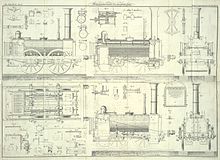George Stephenson
George Stephenson (born June 9, 1781 in Wylam near Newcastle upon Tyne , Northumberland , † August 12, 1848 in Tapton House near Chesterfield ) was an English engineer and the main founder of the railway system . He was self-taught and acquired extensive technical knowledge.
Life
George Stephenson was born to poor parents. At the age of 14 he had to work in a coal mine . His first job was operating a steam engine . His father went blind in an accident with a steam engine. This accident caused Stephenson to work intensively with the steam engines. Soon he was called a machine doctor in northeast England . It was characterized by the functional installation of a pump mechanism. He became overseer and later ran the coal works of Lord Ravensworth near Darlington.
In 1803 his son Robert was born. His wife died two years later. Despite his relatively good position in the coal industry, Stephenson had to repair shoes to give his son the good schooling he had been denied himself. Together with his son he improved his own reading and writing skills.
In 1814 he built a steam locomotive for the railway there , which for a long time was regarded as the first usable locomotive . It was not recognized that the first steam locomotive, built by Richard Trevithick in 1802, failed not because of the locomotive technology but because of the cast-iron rails of the original horse-drawn tram , for which the locomotive was simply too heavy. In fact, two rack- and-pinion locomotives built by Matthew Murray in 1812 under Trevithick's license had been operating to satisfaction for twenty-two years for the coal mine directed by John Blenkinsop . In 1813, William Hedley was already building his " Puffing Billy " for the Wylam colliery, which proved so successful that several locomotives of this type were built. So George Stephenson was not the inventor of the steam locomotive, but he was the most successful railway pioneer of the early 19th century. In parallel with Humphry Davy ( Davy's safety lamp ), Stephenson invented a safety lamp for miners.
Under the direction Stephenson was born on September 27, 1825 between Stockton and Shildon the first public railway in the world was inaugurated. His “Locomotion” was harnessed to 38 wagons , some of which were loaded with coal and wheat. Most of the carriages, however, had seats for around 600 festival participants. The day after, regular operation began with the “Experiment” passenger car , which, however, was pulled by a horse for years. Three locomotives designed by Stephenson drove on this route. The tracks had a gauge of 4 feet 8½ inches (mm 1435, standard gauge ).
The construction of the Liverpool-Manchester Railway in 1829 established its reputation forever. In the famous Rainhill race for the best and fastest locomotive on this line, which was supposed to pull three times its weight at 10 English miles an hour without producing smoke, The Rocket by George Stephenson and his son Robert won the prize by using it pulled five times the weight and covered 14 to 20 English miles an hour, so far exceeded the requirements. This success was mainly due to the introduction of the blowpipe and tubular kettle . The blowpipe improved combustion, while the tubular boiler was able to generate greater steam.
From then on, Stephenson directed the construction of the most important railways in England or built machines for them and was appointed to Belgium, Holland, France, Germany, Italy and Spain for the same purpose. The first German Adler locomotive came from the mechanical engineering company established in Newcastle-upon-Tyne. From 1847 to 1848 George Stephenson was President of the Institution of Mechanical Engineers .
He was most recently the owner of several coal mines and the great ironworks of Claycross and died on August 12, 1848 in Tapton House near Chesterfield. His statue was placed on Stephenson Bridge in Newcastle.
His only son, Robert Stephenson, was also an engineer. This was the godfather of Robert Baden-Powell , the founder of the scout movement.
Others
Due to its importance for the railroad traffic, the street with the main administration of the passenger traffic of the Deutsche Bahn AG in Frankfurt am Main was named after Stephenson.
See also
literature
- Samuel Smiles : The Life of George Stephenson. London 1884 (Reprinted by University Press of the Pacific, 2001, ISBN 0-89875-505-0 )
- Quirin Engasser (ed.): Great men of world history. 1000 biographies in words and pictures . Neuer Kaiser Verlag, Klagenfurt 1987, ISBN 3-7043-3065-5 , p. 446
- LTC Rolt George and Robert Stephenson: the railway revolution , Longmans Green 1960, Reprint Amberley Press 2010
Web links
- Literature by and about George Stephenson in the catalog of the German National Library
- Detailed description of the inauguration drive on September 27, 1825 (English)
- Detailed biography
- Article by / about George Stephenson in the Polytechnic Journal
Individual evidence
- ^ About the locomotive machine of Mr. R. Stephenson. From the Portefeuille industriel du Conservatoire des arts et métiers. Tome premier. In: Polytechnisches Journal . 59, 1836, p. 401.
| personal data | |
|---|---|
| SURNAME | Stephenson, George |
| BRIEF DESCRIPTION | British engineer |
| DATE OF BIRTH | June 9, 1781 |
| PLACE OF BIRTH | Wylam , Northumberland |
| DATE OF DEATH | August 12, 1848 |
| Place of death | Chesterfield , England |



